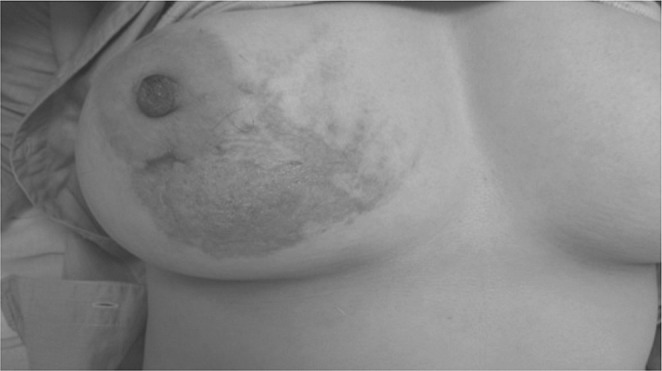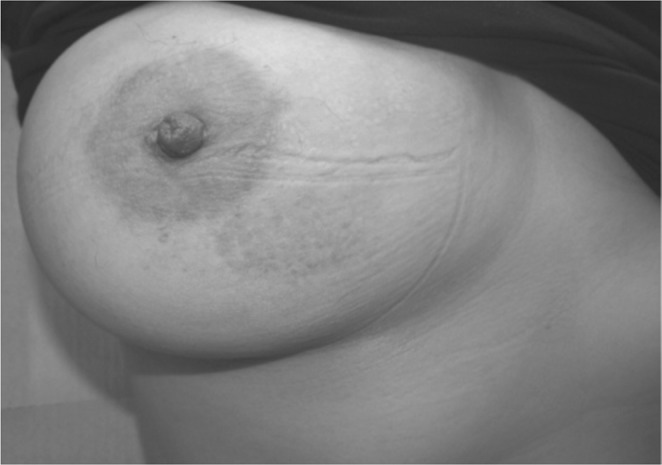Summary
This paper presents an unusual case of frostbite injury to the breast area caused by faulty cryotherapy application. Cryotherapy, commonly used by patients and health professionals, relieves pain and edema after trauma and sports injuries. However, applying cold therapy is not common for surgical procedures involving soft tissue. The frostbite injury to the breast presented here occurred due to persistent use of a self-prepared ice pack following a needle aspiration biopsy. Cold exposure to soft tissue may cause frostbite. It is crucial to inform patients about proper application of cryotherapy and possible complications, particularly for the procedures in which cold therapy is not widely used.
Keywords: breast needle biopsy, cryotherapy, frostbite
Abstract
Cet article présente un cas inhabituel d’engelures à la zone de la poitrine provoqué par l’application inappropriée de la cryothérapie. La cryothérapie, couramment utilisée par les patients et les professionnels de la santé, soulage la douleur et l’oedème après un traumatisme et les blessures sportives. Toutefois, l’application de thérapie par le froid n’est pas commune pour les procédures chirurgicales impliquant les tissus mous. Les engelures au sein présentées ici ont eu lieu en raison de l’utilisation persistante d’un sac de glace auto-préparé à la suite d’une biopsie à l’aiguille. L’exposition au froid des tissus mous peut causer des gelures. Il est essentiel d’informer les patients sur la bonne application de la cryothérapie et les complications possibles, en particulier pour les procédures dans lesquelles la thérapie par le froid n’est pas largement utilisée.
Introduction
Extremities and peripheral parts of the body, particularly fingers, toes, ears and nose, are prone to frostbite injury due to environmental cold exposure.1 However, to the best of our knowledge, localized frostbite injury effecting only central parts of body, namely the thorax, has never been reported. Patients and medical professionals widely use cold therapy after trauma or sports injuries for pain relief and its anti-inflammatory effects. In the case presented herein, the frostbite injury to the breast was due to an inappropriate use of cryotherapy treatment.
Case Report
A 54-year-old female patient presented with second degree frostbite injury on her right breast after ice pack application. A fine needle aspiration biopsy was performed on the patient three days before her presentation. The patient was advised to apply an ice pack to the biopsy site of the breast. After the biopsy, the patient persistently applied a self-prepared cold plastic bag, containing ice, to her breast for six hours, wrapping it only in a thin cloth. She replaced the ice in the bag to keep it cold during this therapy. The day after the biopsy, the patient noticed the hyperemia, blistering and slough on her breast. She applied topical ointment on the lesion and did not seek professional support until the third day. On her initial examination, 1% of the total body surface area on her right breast was determined to have a second degree, deepithelizated frostbite injury (Fig. 1). The patient was treated with daily wound cleansing and application of vaseline and chlorhexidine gluconate impregnated paraffin dressings for 14 days. In this case, due to the superficial second degree burn nature of the frostbite, the wound could be treated without any surgical intervention. The frostbite healed uneventfully within 14 days. However, there was a visible pigmentation disorder on the recovered injury site one month after the frostbite (Fig. 2). The patient was advised to protect the effected region from sun either by clothing and/or sun protection creams.
Fig. 1. Frostbite injury of the breast.

Fig. 2. Pigmentation disorder one month after the initial frostbite.

Discussion
The use of ice packs or cryotherapy decreases the tissue temperature by causing vasoconstriction. Low temperatures reduce the oxygen consumption and tissue metabolism. Topical cold application affects the skin and soft tissues to a depth of 2-4cm. Intermittent use of ice packs on soft tissue decreases blood flow by 26%. Owing to these physiologic effects, cryotherapy reduces pain, spasms, metabolism, blood flow, inflammation and edema.2,3 Cold therapy is used by some plastic surgeons as a standard of care after rhinoplasty procedures and by orthopedic surgeons for joint pathologies to relieve edema and pain. Still, it is not very common to use cold therapy after surgical interventions regarding soft tissue.
Inappropriate cryotherapy may cause frostbite injury as in other types of cold exposures. Freezing temperatures causes the development of ice crystals in the cell. Intracellular ice crystals disrupt the cellular architecture resulting in necrosis and tissue loss.1,4
Conclusion
The use of cryotherapy to decrease inflammation, pain and blood flow, even after minimal invasive procedures, should be conducted cautiously. Either due to insufficient instructions or poor patient compliance, inappropriate continuous application of the ice pack without protecting the skin from direct contact with the cold may easily cause frostbite. Recommending patients commercially available icepacks and suggesting they follow the manufacturer’s instructions usually prevents such injuries. However, it is not unusual for patients to use self-prepared ice packs as a practical method. Thus it is crucial to inform both patients and health professionals about proper application of cryotherapy and possible complications even after simple minimal invasive procedures.
References
- 1.Thomas D, McMillan W, Mills N, et al. An unusual case of intraoral frostbite. Burns. 2004;30:199–202. doi: 10.1016/j.burns.2003.09.026. [DOI] [PubMed] [Google Scholar]
- 2.Nadler SF, Weingand K, Kruse RJ. The physiologic basis and clinical applications of cryotherapy and thermotherapy for the pain practitioner. Pain Physician. 2004;7:395–9. [PubMed] [Google Scholar]
- 3.Ho SS, Coel MN, Kagawa R, et al. The effects of ice on blood flow and bone metabolism in knees. Am J Sports Med. 1994;22:537–40. doi: 10.1177/036354659402200417. [DOI] [PubMed] [Google Scholar]
- 4.Iliopoulou E, Lochaitis A. Frostbite - Exceptional cases. Ann Burns Fire Disasters. 2003;16:38–43. [Google Scholar]


